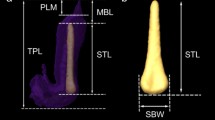Abstract
The penis of the recently described mole Talpa martinorum and its relative, the European mole Talpa europaea, are described and compared. Considerable differences in the morphology of the glans penis were found: the apical part is narrow and rod-like in T. martinorum and conical in T. europaea; the keratinous papillae covering the basal part of the glans are shorter and in fewer groups in T. martinorum than in T. europaea. The os penis is nearly 30 % longer in T. martinorum than in the other species. The corpora cavernosa in both mole species are well developed and uniformly organized from the base of the penis to its apical region. The urethra is dorsoventrally flattened and widened in the apical part. Seasonal development of the keratinous papillae is observed in both species: they are found only during the breeding season. This phenomenon has never been reported before in any mammalian group.





Similar content being viewed by others
Data availability
Data are available on request from the authors. The material (voucher specimens, slides) is preserved in the National Museum of Natural History, Sofia, Bulgaria.
Code availability
Not applicable.
References
Altuna C, Lessa E (1985) ) Penial morphology in Uruguayan species of Ctenomys (Rodentia: Octodontidae). J Mammal 66(3):483–488
Brindle M, Opie Ch (2016) Postcopulatory sexual selection influences baculum evolution in primates and carnivores. Proc R Soc B 283:1–7. https://doi.org/10.1098/rspb.2016.1736
Burt WH (1960) Bacula of North American mammals. Univ Mich Misc Publ Mus Zool 113:1–75
Deparma NK (1954) The method of age determination in moles. Bull Mosc Soc Natur Biol Ser 59(6):11–25 (in Russian)
Dolgov V (1985) Brown-toothed shrews of the Old World. Moscow University Publ., Moscow [in Russian]
Gorman ML, Stone RD (1990) The natural history of moles. Cornell University Press, New York
Kefelioğlu H, Gençoğlu S (1996) Taxonomy and distribution of moles (Mammalia: Insectivora) of Black Sea region in Turkey. Turk J Zool 20:57–66 [in Turkish]
Kryštufek B, Motokawa M (2018) Family Talpidae (moles, desmans, star-nosed moles and shrew moles). In: Wilson DE, Mittermeier RA (eds) Handbook of the Mammals of the World, vol 8. Insectivores, Sloths and Colugos. Lynx Edicions, Barcelona, pp 552–559
Kryštufek B, Davison A, Griffiths HI (2000) Evolutionary biogeography of water shrews (Neomys spp.) in the western Palaearctic Region. Can J Zool 78(9):1616–1625. https://doi.org/10.1139/z00-105
Kryštufek B, Nedyalkov N, Astrin J, Hutterer R (2018) News from the Balkan refugium: Thrace has an endemic mole species (Mammalia: Talpidae). Bonn Zool Bull 67(1):41–57
Kryštufek B, Shenbrot G, Klenovšek T, Janžekovič F (2020) Geometric morphometrics of mandibular shape in the dwarf fat-tailed jerboa: relevancy for trinomial taxonomy. Zool J Linn Soc. https://doi.org/10.1093/zoolinnean/zlaa130
Nagorsen DW, Peterson RL (1980) Mammal collectors’ manual: a guide for collecting, documenting, and preparing mammal specimens for scientific research. Life Sciences Miscellaneous Publications, Toronto
Nicolas V, Martínez-Vargas J, Hugot JP (2015) Preliminary note: Talpa aquitania nov. sp. (Talpidae, Soricomorpha) a new mole species from southwest France and north Spain. Bull Acad Vet Fr 168:329–334. https://doi.org/10.4267/2042/58283
Patterson B (1983) Baculum-body size relationships as evidence for a selective continuum on bacular morphology. J Mammal 64(3):496–499. https://doi.org/10.2307/1380362
Patterson BD, Thaeler CS Jr (1982) The mammalian baculum: hypotheses on the nature of bacular variability. J Mammal 63(1):1–15. https://doi.org/10.2307/1380665
Rigueur D, Lyons KM (2014) Whole-mount skeletal staining. In: Hilton MJ (ed) Skeletal development and repair: Methods and protocols. Methods in Molecular Biology, vol 1130. Humana, Totowa, pp 113–121. https://doi.org/10.1007/978-1-62703-989-5_9
Romer AS, Parsons TS (1986) The vertebrate body, 6th edn. Saunders College Publishing, Philadelphia
Sinclair AW, Glickman SE, Catania KC, Shinohara A, Baskin L, Cunha GR (2017) Comparative morphology of the penis and clitoris in four species of moles (Talpidae). J Exp Zool 328:275–294. https://doi.org/10.1002/jez.b.22732
Van der Horst G (1972) Seasonal effects on the anatomy and histology of the reproductive tract of the male rodent mole Bathyergus suillus suillus (Schreber). Zool Afr 7(2):491–520
Vinogradov S (1958) On the structure of external genitalia in white-toothed shrews (genus Crocidura, Insectivora, Mammalia) as a classificatory. Zool Zh 37(8):236–1242 [in Russian]
Williams S (1982) Phalli of recent genera and species of the family Geomyidae (Mammalia: Rodentia). Bull Carnegie Mus Nat Hist 20:1–62
Woodall PF (1995) The penis of elephant shrews (Mammalia: Macroscelididae). J Zool 237:399–410. https://doi.org/10.1111/j.1469-7998.1995.tb02770.x
Yudin B (1989) Insectivore mammals of Siberia. Nauka, Novosibirsk [in Russian]
Acknowledgements
This study is supported by the National Science Fund of the Republic of Bulgaria, grant No. КП-06-М21 − 8/18.12.2018. We are grateful to Jon Hall (New York, USA) for the linguistic improvement and to Georgi Popgeorgiev (National Museum of Natural History, Sofia, Bulgaria) for the useful advices on an earlier draft of the manuscript.
Funding
This study is supported by the National Science Fund of the Republic of Bulgaria, grant No. КП-06-М21 − 8/18.12.2018.
Author information
Authors and Affiliations
Contributions
All authors contributed equally to the design and performance of the study and writing of the manuscript.
Corresponding author
Ethics declarations
Conflicts of interest/Competing interests
The authors have no conflicts of interest to declare that are relevant to the content of this article.
Ethics approval
This article does not contain any studies with human participants or living animals performed by any of the authors. All applicable international, national, and/or institutional guidelines for the care and use of animals were followed.
Consent to participate
Not applicable.
Consent for publication
All authors agree to publish the results of the study. The article has not been published before and is not being considered for publication elsewhere.
Additional information
Publisher’s note
Springer Nature remains neutral with regard to jurisdictional claims in published maps and institutional affiliations.
Supplementary Information
ESM 1
(DOC 70.0 KB)
Rights and permissions
About this article
Cite this article
Nedyalkov, N., Vergilov, V. & Zlatkov, B. Penis morphology of two European mole species (Soricomorpha, Talpidae). Biologia 76, 2519–2525 (2021). https://doi.org/10.1007/s11756-021-00738-5
Received:
Accepted:
Published:
Issue Date:
DOI: https://doi.org/10.1007/s11756-021-00738-5




